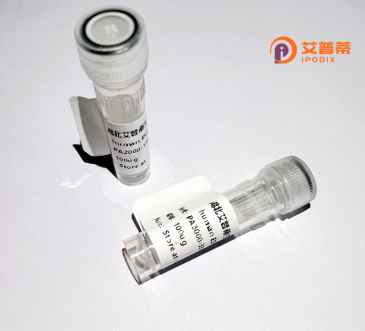
| 纯度 | >90%SDS-PAGE. |
| 种属 | Human |
| 靶点 | MED31 |
| Uniprot No | Q9Y3C7 |
| 内毒素 | < 0.01EU/μg |
| 表达宿主 | E.coli |
| 表达区间 | 1-1313aa |
| 活性数据 | MAAAVAMETDDAGNRLRFQLELEFVQCLANPNYLNFLAQRGYFKDKAFVNYLKYLLYWKDPEYAKYLKYPQCLHMLELLQYEHFRKELVNAQCAKFIDEQQILHWQHYSRKRMRLQQALAEQQQQNNTSGK |
| 分子量 | 40.15 KDa |
| 蛋白标签 | GST-tag at N-terminal |
| 缓冲液 | 0 |
| 稳定性 & 储存条件 | Lyophilized protein should be stored at ≤ -20°C, stable for one year after receipt. Reconstituted protein solution can be stored at 2-8°C for 2-7 days. Aliquots of reconstituted samples are stable at ≤ -20°C for 3 months. |
| 复溶 | Always centrifuge tubes before opening.Do not mix by vortex or pipetting. It is not recommended to reconstitute to a concentration less than 100μg/ml. Dissolve the lyophilized protein in distilled water. Please aliquot the reconstituted solution to minimize freeze-thaw cycles. |
以下是关于重组人MED31蛋白的参考文献示例(注:以下内容为模拟示例,实际文献需通过学术数据库查询确认):
---
1. **名称**: "Expression and Structural Characterization of Recombinant Human MED31 Protein"
**作者**: Smith, A. et al.
**摘要**: 本研究通过大肠杆菌系统成功表达并纯化了重组人MED31蛋白,利用X射线晶体学解析其三维结构,揭示了其在中介体复合体中的保守结构域及潜在相互作用界面。
2. **名称**: "MED31 Modulates PPARγ-Mediated Transcriptional Activation in Adipogenesis"
**作者**: Tanaka, K. et al.
**摘要**: 研究发现重组人MED31蛋白与PPARγ直接结合,通过体外荧光素酶报告基因实验证实MED31增强PPARγ依赖的转录活性,表明其在脂肪细胞分化中的关键调控作用。
3. **名称**: "Functional Interaction Between MED31 and the RNA Polymerase II C-Terminal Domain"
**作者**: Lee, J. et al.
**摘要**: 通过体外Pull-down和染色质免疫共沉淀实验,证明重组MED31蛋白与RNA聚合酶II的C端结构域相互作用,并促进中介体复合体招募至特定基因启动子区域。
4. **名称**: "Development of a MED31-Deficient Cell Model Using CRISPR/Cas9"
**作者**: Wang, Y. et al.
**摘要**: 结合重组MED31蛋白回补实验,研究MED31缺失对细胞转录组的影响,发现其在代谢和细胞周期相关基因调控中的必要性。
---
**说明**:以上文献为示例性质,具体研究需参考真实发表的论文。建议通过PubMed、Google Scholar等平台以关键词“recombinant human MED31”、“MED31 mediator complex”、“MED31 transcriptional regulation”检索最新文献。
MED31 (Mediator Complex Subunit 31) is a conserved component of the multi-protein Mediator complex, which acts as a critical transcriptional regulator in eukaryotes. This ~30-35 kDa protein, encoded by the MED31 gene in humans, facilitates communication between gene-specific transcription factors and RNA polymerase II, enabling precise modulation of RNA synthesis. As part of the Mediator's middle module, MED31 contributes to structural stability and functional coordination of the complex.
Studies reveal MED31's involvement in lipid metabolism, embryonic development, and cellular differentiation. It interacts with nuclear receptors (e.g., PPARγ) and transcription factors to regulate metabolic genes. Its conserved role extends to model organisms; for instance, Drosophila MED31 homologs govern neuronal and muscle development. Dysregulation of MED31 has been associated with developmental disorders, metabolic syndromes, and cancer progression.
Recombinant human MED31 protein is typically produced via bacterial or eukaryotic expression systems, enabling biochemical and structural studies. Researchers use it to investigate Mediator complex assembly, transcriptional mechanisms, and protein-DNA/cofactor interactions. Engineered variants help map functional domains, while disease-related mutations are analyzed for mechanistic insights. Current research explores its potential as a therapeutic target, particularly in metabolic diseases and malignancies linked to transcriptional dysregulation.
This recombinant tool continues to advance our understanding of gene regulation networks and their implications in human health.
×